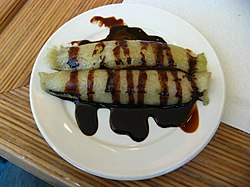Latik
 | |
| Type | Dessert topping |
|---|---|
| Place of origin | Philippines |

Latík (Tagalog pronunciation: [laˈtɪk] la-TIK) refers to two different coconut-based ingredients in Philippine cuisine. In the northern parts it refers to solid coconut curds, the byproducts of coconut oil production, used as garnishing for a variety of desserts. In the Visayan region it refers to a syrupy caramelized coconut cream used as a dessert sauce.
Tagalog Latík
Latík in Luzon is made from coconut milk simmered in a saucepan until it reduces to coconut oil and solids ("coconut curds") begin to form at the top surface. These solids are left to fry in the coconut oil until golden brown.[1][2]
Latík is commonly used as topping for a variety of Philippine dishes including maja blanca, sapin-sapin, and ube halaya.[3][4]
They are sometimes mistaken for fried caramelized coconut flesh (another type of garnishing/dessert known as bukayo in Bisaya).[1]
Visayan Latik
Latík in its original sense in the Visayan languages literally means 'syrup' (equivalent to arnibal in Hiligaynon). It can refer to any type of thick sweetened liquids including jam.[5] In the most common usage, however, latik means a syrupy condiment derived from reducing coconut milk and sugar.[6][7]
It is used much in the same way as syrup, in dishes like kalamay and suman.[8]
It is sometimes translated into English as "coconut caramel".[9]
See also
- List of condiments
- List of dessert sauces
- List of Philippine dishes
- Maglalatik (literally "latik maker"), an indigenous Philippine dance
- Philippine condiments
References
- ^ a b "Latik / Fried Coconut Milk Solids". Market Manila. August 5, 2008. Retrieved July 5, 2011.
- ^ Vanjo Merano (March 25, 2010). "How to Make Latik". Panlasang Pinoy. Retrieved July 5, 2011.
- ^ Reynaldo G. Alejandro; Doreen G. Fernandez (1998). Food of the Philippines. Tuttle Publishing. p. 102. ISBN 978-962-593-245-3.
- ^ Philippines. Dept. of Education, Culture, and Sports (1989). Duyan ng magiting: the folk culture of the southern Tagalog region. Kalinangan series. Vol. Volume 3. IMC. ISBN 978-971-10-1241-0.
{{cite book}}:|volume=has extra text (help)CS1 maint: multiple names: authors list (link) - ^ "latik". Binisaya.com. Retrieved July 5, 2011.
- ^ "Bisaya translation for "latik"". Bisaya Translator and Cebuano Dictionary. Retrieved July 5, 2011.
- ^ "Philippine quarterly of culture and society". 32. University of San Carlos. 2004: 31.
{{cite journal}}:|access-date=requires|url=(help); Cite journal requires|journal=(help) - ^ "Suman Latik". Lutong Bahay. Retrieved July 5, 2011.
- ^ Goldstein, Darra (2015). The Oxford Companion to Sugar and Sweets. Oxford University Press. p. 530. ISBN 9780199313396.

